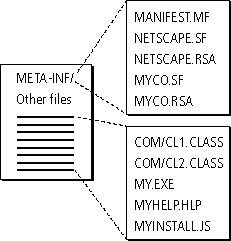
This document describes the Java archive (JAR) format, a set of conventions for associating digital signatures, installer scripts, and other information with files in a directory. Signing tools such as the JAR Packager use this format to create JAR archive files, which are used by Communicator client software to support automatic software installation, user-controlled access to local system resources by Java applets, and other features that help address potential security problems.
The JAR file type is a registered Internet MIME type based on the standard cross-platform ZIP archive format. A JAR file functions as a digital envelope for a compressed collection of files. The JAR file type is distinct from the JAR format, which is simply a way of organizing information in a directory.
This document is intended for developers who want to package files into a JAR archive without using the JAR Packager or who want to write software that can create JAR archives.
For information about hashing algorithms, digital signatures, and other aspects of cryptography mentioned in this document, see Applied Cryptography by Bruce Schneier (Wiley, 1996).
Every JAR archive is organized according to the scheme outlined in Figure 1.1.

A JAR archive has a subdirectory of meta-information named META-INF. This subdirectory contains the following:
You can use the JAR archive format to package files even if you don't want to sign any of them. In this case, you won't have any signature instruction files or digital signature files.
In addition to the MANIFEST.MF subdirectory, the archive contains whatever files you want to package in the archive, such as the files to be installed using the automatic software installation feature of Communicator. These files can be arranged hierarchically. For automatic software installation, one of those files must be the installer for the package.
To create a JAR file from scratch (that is, without using the JAR Packager or a similar signing tool), follow these steps:
A JAR archive contains exactly one manifest file. The manifest file is an ASCII file named MANIFEST.MF and is in the META-INF directory. Its filename should be generated as uppercase, but should be recognizable using any case.
A manifest file is created from the files in the archive, as shown in Figure 1.2.
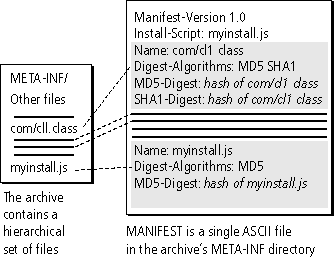
In Figure 1.2, lines in the archive box indicate individual files, as do the filenames. In the manifest box, the lines indicate lines in the actual file.
The manifest file has sections for a subset of the files in the archive. Not all files in the archive need be included in the manifest. These sections can use RFC822-style headers to store arbitrary information associated with a file, such as the encoding of the file, its language, or its creator.
For automatic software installation, the manifest file must contain a section for the installer. This section must contain the name of the installer and the Install-Script keyword indicating that it is the installer. This section can contain any other appropriate information about the installer.
The manifest file must include sections for all files that are to be signed. The manifest file must not be one of the files referred to in itself.
The following is an example manifest file, including the base 64 representation of the relevant hashes:
Manifest-Version: 1.0 Install-Script: myinstall.js
Name: com/cl1.class Digest-Algorithms: MD5 SHA1 MD5-Digest: CmnX58sSgpufbr2RW/WgStS= SHA1-Digest: 6goIqkIAUwu6T+sOs3O+hURpLRQ=
Name: com/cl2.class Digest-Algorithms: MD5 MD5-Digest: EnpY95pTfqytbr1MV/RgKwR=
Name: myinstall.js Digest-Algorithms: MD5 MD5-Digest: DnpX49tTgqygak1LH/YgTw==
A preliminary portion appears at the top of the manifest file containing this standard's version number:
Manifest-Version: 1.0
Optionally, a version required for use may also be specified. This indicates that only tools of the given version or later can be used to manipulate the file. It looks like:
Required-Version: 1.0
If Version is higher than Required-Version, extensions may be used.
After the preliminaries, the manifest file consists of sections, each of which represents a file in the archive. In general, a section specifies a file in the archive, the names of one or more hashing algorithms used on that file (although this is optional), and a hash (also called digest) value of the file for each of those algorithms.
For use with Netscape products, the file should be hashed with either the MD5 or SHA1 algorithm. It is beyond the scope of this document to tell you how to produce the hash value for your file using your chosen hashing algorithm; for more information, see Applied Cryptography by Bruce Schneier (Wiley, 1996).
A section can also contain other headers not covered here. These may include information used by applications for their own purposes.
The following is a grammar for a manifest file. In the grammar, items in quotation marks are literals to be entered exactly as they appear, without the surrounding quotation marks. Other items are placeholders defined elsewhere in the grammar.
manifest-file: "Manifest-Version: 1.0" newline optional-header newline manifest-start *manifest-entry
manifest-start: section
manifest-entry: section
optional-header: "Required-Version: " number
section:
"Name: " filename newline
"Digest-Algorithms: " algorithm-list newline
+{algorithm "-Digest: " (base64 representation of hash) newline}
*header +newline
algorithm-list: algorithm *whitespace algorithm-list | algorithm
algorithm: +headerchar
filename: any filename supported by the format used to package the JAR archive
header: alphanum *headerchar ":" SPACE *otherchar newline *continuation
continuation: SPACE *otherchar newline
alphanum: {"A"-"Z"} | {"a"-"z"} | {"0"-"9"}
headerchar: alphanum | "-" | "_"
otherchar: any Unicode character except NUL, CR and LF
number: +{"0"-"9"} "." +{"0"-"9"}
newline: CR LF | LF | CR (not followed by LF)
whitespace: "," | SPACE | TAB | NEWLINE
For further information about this file format, see "Additional File Information".
To associate digital signatures with files in a JAR archive, you need several files in the META-INF directory of the archive. Figure 1.3 shows the necessary files.
Figure 1.3 Files involved in a signed archive
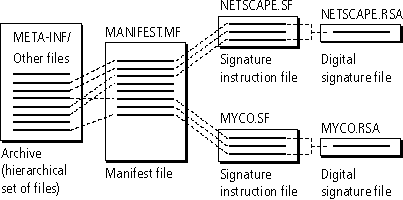
In Figure 1.3, each line in the archive box represents a file. In all of the other boxes, each line represents a section of the individual file.
These are the files listed in the META-INF directory:
The following sections explain in more detail the contents of each file and how each is created.
CREATING A SIGNATURE INSTRUCTION FILEThe manifest file simply lists the files in the archive that are to be signed. It does not associate signatures with any of those files. Between them, this is the function of signature instruction files and the digital signature files.
A JAR archive has a pair of signature instruction and digital signature files for each signer of one or more files in the archive. For example, an archive that contains two signed by Netscape and two files signed by MyCo contains these four files:
NETSCAPE.SF NETSCAPE.RSA MYCO.SF MYCO.RSA
You create the signature instruction file first and then create the digital signature file from it. This section describes the contents of the signature instruction file; see "Creating a Digital Signature File" for a description of the digital signature file.
As shown in Figure 1.4, each signature instruction file corresponds to one signer to the archive. It is an error to have multiple signers in the same signature file. If more than one signature is found, additional signatures may be ignored.
The purpose of signature instruction files is to allow policy to be embedded in headers supplied by the signer rather than by the manifest owner (who is normally the person who generates the archive).
Figure 1.4 The signature instruction files
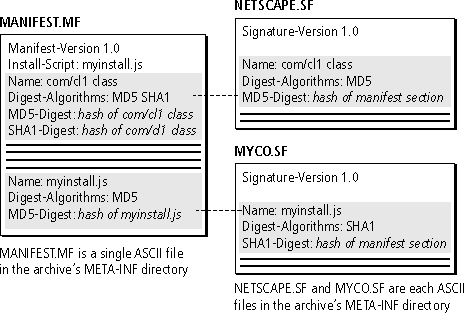
A signature instruction file has a name of the form name.SF where name contains only the characters A-Z, 0-9, and dash or underscore. name must not be more than 8 characters.
Note that the header section of the MANIFEST.MF file may optionally have a corresponding section in each signature instruction file that contains a hash of the header section. This can be useful if the manifest header contains sensitive information that you wish to be able to validate.
The following is a sample signature instruction file:
Signature-Version: 1.0
Name: com/cl1.class Digest-Algorithms: MD5 SHA1 MD5-Digest: DnpZ49tTfqyfbr1MV/YgTw==
Name: com/cl2.class Digest-Algorithms: MD5 MD5-Digest: QmsW83uUfpzgad2NH/WkMx==
A preliminary portion appears at the top of a signature instruction file containing, at minimum, this standard's version number:
Signature-Version: 1.0
Policy information supplied by the signer but not specific to any particular pathname should be included here.
The sections in a signature instruction file correspond to sections in the manifest file (and hence to files in the archive). There is one section for each file for which this signer claims responsibility. These sections are similar in form to those in the manifest file.
In general, a section specifies a file in the archive, the names of one or more hashing algorithms used on the manifest section corresponding to that file, and hashes of the section using each of those algorithms.
Once again, you must use the MD5 or SHA1 hashing algorithm. It is beyond the scope of this guide to tell you how to produce hash values.
As with a manifest file, a section can also contain other headers not covered here and which are ignored by Netscape.
Sections appearing in the manifest file but not in the signature file are not used in calculating the security of the archive. This allows subsets of the archive to be signed.
The following is the grammar for a signature instruction file. In the grammar, items in quotation marks are literals that are to be entered exactly as they appear, without the surrounding quotation marks. Other items are placeholders defined elsewhere in the grammar.
signature-file: "Signature-Version: 1.0" newline optional-header newline signature-start *signature-entry
signature-start: section
signature-entry: section
optional-header: "Required-Version: " number
section:
"Name: " filename newline
optional-"Digest-Algorithms: " algorithm-list newline
+{algorithm "-Digest: " (base64 representation of hash) newline}
*header +newline
algorithm-list: algorithm *whitespace algorithm-list | algorithm
algorithm: +headerchar
filename: any filename supported by the format used to package the JAR archive
header: alphanum *headerchar ":" SPACE *otherchar newline *continuation
continuation: SPACE *otherchar newline
alphanum: {"A"-"Z"} | {"a"-"z"} | {"0"-"9"}
headerchar: alphanum | "-" | "_"
otherchar: any Unicode character except NUL, CR and LF
number: +{"0"-"9"} "." +{"0"-"9"}
newline: CR LF | LF | CR (not followed by LF)
whitespace: "," | SPACE | TAB | NEWLINE
The signature of the signature instruction file is first verified when the manifest is first parsed. This verification can be remembered, for efficiency. This only validates the signature directions themselves, not the actual archive files.
To validate a file, the hash value in the signature file is compared against a hash calculated against the corresponding entry in the manifest file. Then, a hash value in the manifest file is compared against a hash calculated against the actual data referenced in the Name header, which is either a relative path or a URL.
Some URLs may refer to data that cannot be signed; for example, telnet URLs cannot be signed. Hashes on URLs where signing is sensible are calculated on data only and do not include HTTP or FTP overhead.
CREATING A DIGITAL SIGNATURE FILEA JAR archive has at least one digital signature file for each signature instruction file in the archive, as shown in Figure 1.5. A digital signature file is a signed version of the signature instruction file. It is a binary file not intended to be interpreted by humans.
Figure 1.5 Digital signature files
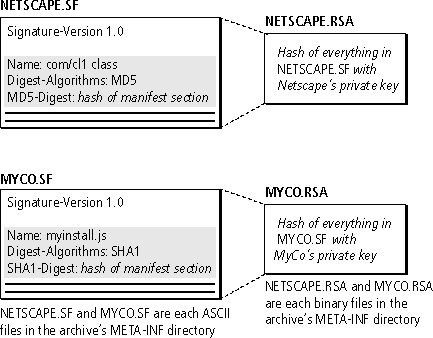
A digital signature file has the same name as its corresponding signature instruction file, but with a suffix corresponding to the type of digital signature. For example, if the archive contains the signature instruction file NETSCAPE.SF, it must also contain a digital signature file, such as NETSCAPE.RSA.
Netscape products understand files signed with the PKCS #7 signature using MD5 and RSA to sign it. These files have a suffix of RSA. Other possible suffixes are .DSA for a PKCS #7 signature using DSA and .PGP for a Pretty Good Privacy signature. In general, suffixes may be 1 to 3 alphanumeric characters. Suffixes for unrecognized filetypes are ignored.
For those formats that do not support external signed data, the digital signature file consists of a signed copy of the signature instruction file. Thus some data may be duplicated and a verifier ought to compare the two files.
Formats that support external data either refer to the signature instruction file or perform calculations on it with implicit reference.
Each signature instruction file may have multiple digital signatures, but those signatures ought to be generated by the same legal entity.
If is beyond the scope of this document to tell you how to create a digital signature file from a private key and a given file.
ADDITIONAL FILE INFORMATIONThis section describes additional information about the manifest and signature instruction file formats.